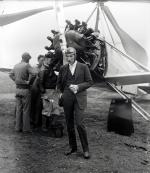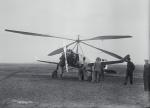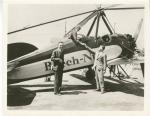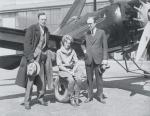![header=[Marker Text] body=[The noted aeronautical pioneer established his first flying field on this site in 1924. The 1930 Collier Trophy, an award for accomplishments in aviation, was presented to Pitcairn and his associates for developing the American autogiro, first introduced here. ] sign](http://explorepahistory.com/kora/files/1/10/1-A-352-139-ExplorePAHistory-a0l3l9-a_450.gif)
Mouse over for marker text
Name:
Harold F. Pitcairn
Region:
Philadelphia and its Countryside/Lehigh Valley
County:
Montgomery
Marker Location:
Buck and Paper Mill Rds., Bryn Athyn
Dedication Date:
April 19, 1972
Behind the Marker
In the early days of aviation and automobiles, many dreamed of a craft that could both fly and travel on the ground. In the 1930s, Pennsylvania's Pitcairn Autogiro Company promised that Americans would soon be commuting from home to work in an "autogiro," a novel aircraft said to be safe, easy to fly, and able to access city rooftops or suburban lawns with ease.
The principal of autorotation had been known for centuries, but it was Spanish engineer Juan de la Cierva who in 1923 merged it with a conventional airplane into a new craft he called an "Autogiro." Like a helicopter, an autogiro had horizontal blades on top (usually four), but unlike a helicopter, they were not connected to an engine.
De la Cierva's autogiro was propelled forward by a conventional engine-driven propeller. To make it work, he inclined the rotor backward so that the aircraft's forward motion caused it to turn and create lift, spinning against the forward flow much as a sailboat can "tack" into oncoming winds. This non-powered effect became known as "autorotation."
To start the rotor spinning, a crew pulled a rope wound around its shaft. The craft then lifted off the ground after only a short distance. Once in flight, the rotor added stability and safety at low speeds, allowing it to land in confined areas. Unlike early helicopters, de la Cierva's autogiro also could glide to safety if the engine failed.
De la Cierva's autogiro soon came to the attention of Pennsylvanian Harold Pitcairn, who had started his own aviation business at a small airfield northeast of Philadelphia in Bryn Athyn. In 1926, he bought 190 acres in nearby Willow Grove to create Pitcairn Field.
The next year, Pitcairn Aviation began producing the Mailwing, a rugged biplane to serve airmail routes. After conducting experiments with rotary-wing aircraft, Pitcairn in 1929 formed a partnership with de la Cierva to develop autogiro technology in the U.S. He then changed the name of his company to Pitcairn Autogiro Company, and created a subsidiary, Autogiro Company of America, which licensed the autogiro concept to Buhl, Sikorsky, the Kellet Autogiro Company of Philadelphia, and other prospective manufacturers.
 After building a prototype, the PCA-1, Pitcairn fabricated twenty of the follow-up model PCA-2, which in 1931 became the first commercially licensed autogiro in the U.S. To demonstrate its capabilities, Pitcairn got American female aviation pioneer Amelia Earhart to attempt a new altitude record in the craft, which she accomplished on April 8, 1931, when she reached 18,400 feet above Pitcairn Airfield. Earhart then toured the country in a PCA-2 as a promotional stunt for Beech Nut gum, and became the first person to cross the nation in an autogiro.
After building a prototype, the PCA-1, Pitcairn fabricated twenty of the follow-up model PCA-2, which in 1931 became the first commercially licensed autogiro in the U.S. To demonstrate its capabilities, Pitcairn got American female aviation pioneer Amelia Earhart to attempt a new altitude record in the craft, which she accomplished on April 8, 1931, when she reached 18,400 feet above Pitcairn Airfield. Earhart then toured the country in a PCA-2 as a promotional stunt for Beech Nut gum, and became the first person to cross the nation in an autogiro.
The aeronautics community was appropriately impressed. Pitcairn won the 1930 Robert J. Collier Trophy, awarded annually for "the greatest achievement in aeronautics or astronautics in America, with respect to improving the performance, efficiency, and safety of air or space vehicles." For the April 22, 1931 presentation, Pitcairn demonstrated his autogiro to President Herbert Hoover at the White House.
After that, the future looked bright for Pitcairn's autogiro. Autogiro Highlights of 1932 reported that sixty-seven of the aircraft were operating, and that "[p]rivate owners were commuting from home 'autogiro airports." Two well-publicized search-and-rescue operations that autogiros helped with that year added to its reputation.
Perhaps the peak of autogiro popularity came in 1935, when the U.S. Bureau of Commerce's Experimental Division Section awarded a contract to the Autogiro Company to build the Pitcairn AC-35. A two-seater that only required a regular pilot's license to fly, the Roadable Autogiro, as it was also called, featured rotor blades that could be folded back for driving on roads or stowing in one's garage; which led the company to advertise there would soon be "An aircraft in everyone's garage."
Another application with great potential was airmail, since the autogiro could land atop downtown buildings. Even the need for a take-off runway was eliminated by the mid-1930s with the invention of a "jump" technique made possible by adding power to the rotor's start and changing the blades so they could articulate to change their pitch.
Pitcairn Autogiro became Pitcairn Larsen Autogiro in 1940, then G and A Aircraft to handle the company's many military contracts. In 1942, the U.S. Navy purchased Pitcairn Field and expanded it, renaming the site United States Naval Air Station Willow Grove. In 1943, Firestone Aircraft bought out G and A, then built a few other rotary wing aircraft before ceasing production in 1947, due to lack of demand and competition from firms manufacturing helicopters. By the 1950s, it was obvious that the future of rotary aircraft lay with the fully powered rotor.
Autogiros today have no commercial applications but remain popular with amateur aircraft builders who find the crafts lightweight and easy to control. Collectors search out the few remaining classic autogiros. Pitcairn's airfield would fare better than his aircraft. In 1957 the Naval Air Station expanded to its current 1,100 acres, and in 1994 it became the Naval Air Station Joint Reserve Base Willow Grove. Today, nothing remains from Pitcairn Field, which was at the southeast corner of the today's facility.
"[In 1930], a special demonstration was given for the venerable inventor, Thomas Edison, whose helicopter experiments dated back almost fifty years.... Edison commented: 'That's the answer, that's the answer,' and called the Autogiro 'the greatest advance that could have been made in aviation.'"
-Charles Gablehouse, Helicopters and Autogiros, 1969.
In the early days of aviation and automobiles, many dreamed of a craft that could both fly and travel on the ground. In the 1930s, Pennsylvania's Pitcairn Autogiro Company promised that Americans would soon be commuting from home to work in an "autogiro," a novel aircraft said to be safe, easy to fly, and able to access city rooftops or suburban lawns with ease.
The principal of autorotation had been known for centuries, but it was Spanish engineer Juan de la Cierva who in 1923 merged it with a conventional airplane into a new craft he called an "Autogiro." Like a helicopter, an autogiro had horizontal blades on top (usually four), but unlike a helicopter, they were not connected to an engine.
De la Cierva's autogiro was propelled forward by a conventional engine-driven propeller. To make it work, he inclined the rotor backward so that the aircraft's forward motion caused it to turn and create lift, spinning against the forward flow much as a sailboat can "tack" into oncoming winds. This non-powered effect became known as "autorotation."
To start the rotor spinning, a crew pulled a rope wound around its shaft. The craft then lifted off the ground after only a short distance. Once in flight, the rotor added stability and safety at low speeds, allowing it to land in confined areas. Unlike early helicopters, de la Cierva's autogiro also could glide to safety if the engine failed.
De la Cierva's autogiro soon came to the attention of Pennsylvanian Harold Pitcairn, who had started his own aviation business at a small airfield northeast of Philadelphia in Bryn Athyn. In 1926, he bought 190 acres in nearby Willow Grove to create Pitcairn Field.
The next year, Pitcairn Aviation began producing the Mailwing, a rugged biplane to serve airmail routes. After conducting experiments with rotary-wing aircraft, Pitcairn in 1929 formed a partnership with de la Cierva to develop autogiro technology in the U.S. He then changed the name of his company to Pitcairn Autogiro Company, and created a subsidiary, Autogiro Company of America, which licensed the autogiro concept to Buhl, Sikorsky, the Kellet Autogiro Company of Philadelphia, and other prospective manufacturers.
The aeronautics community was appropriately impressed. Pitcairn won the 1930 Robert J. Collier Trophy, awarded annually for "the greatest achievement in aeronautics or astronautics in America, with respect to improving the performance, efficiency, and safety of air or space vehicles." For the April 22, 1931 presentation, Pitcairn demonstrated his autogiro to President Herbert Hoover at the White House.
After that, the future looked bright for Pitcairn's autogiro. Autogiro Highlights of 1932 reported that sixty-seven of the aircraft were operating, and that "[p]rivate owners were commuting from home 'autogiro airports." Two well-publicized search-and-rescue operations that autogiros helped with that year added to its reputation.
Perhaps the peak of autogiro popularity came in 1935, when the U.S. Bureau of Commerce's Experimental Division Section awarded a contract to the Autogiro Company to build the Pitcairn AC-35. A two-seater that only required a regular pilot's license to fly, the Roadable Autogiro, as it was also called, featured rotor blades that could be folded back for driving on roads or stowing in one's garage; which led the company to advertise there would soon be "An aircraft in everyone's garage."
Another application with great potential was airmail, since the autogiro could land atop downtown buildings. Even the need for a take-off runway was eliminated by the mid-1930s with the invention of a "jump" technique made possible by adding power to the rotor's start and changing the blades so they could articulate to change their pitch.
Pitcairn Autogiro became Pitcairn Larsen Autogiro in 1940, then G and A Aircraft to handle the company's many military contracts. In 1942, the U.S. Navy purchased Pitcairn Field and expanded it, renaming the site United States Naval Air Station Willow Grove. In 1943, Firestone Aircraft bought out G and A, then built a few other rotary wing aircraft before ceasing production in 1947, due to lack of demand and competition from firms manufacturing helicopters. By the 1950s, it was obvious that the future of rotary aircraft lay with the fully powered rotor.
Autogiros today have no commercial applications but remain popular with amateur aircraft builders who find the crafts lightweight and easy to control. Collectors search out the few remaining classic autogiros. Pitcairn's airfield would fare better than his aircraft. In 1957 the Naval Air Station expanded to its current 1,100 acres, and in 1994 it became the Naval Air Station Joint Reserve Base Willow Grove. Today, nothing remains from Pitcairn Field, which was at the southeast corner of the today's facility.









